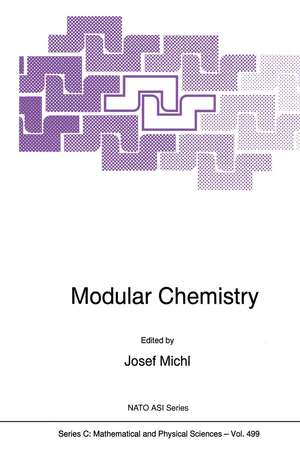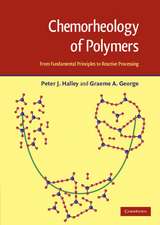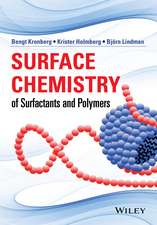Modular Chemistry: Nato Science Series C:, cartea 499
Editat de Josef Michlen Limba Engleză Paperback – 6 noi 2012
| Toate formatele și edițiile | Preț | Express |
|---|---|---|
| Paperback (1) | 411.26 lei 6-8 săpt. | |
| SPRINGER NETHERLANDS – 6 noi 2012 | 411.26 lei 6-8 săpt. | |
| Hardback (1) | 604.70 lei 6-8 săpt. | |
| Kluwer Academic Publishers – 31 aug 1997 | 604.70 lei 6-8 săpt. |
Din seria Nato Science Series C:
- 24%
 Preț: 797.69 lei
Preț: 797.69 lei - 18%
 Preț: 957.62 lei
Preț: 957.62 lei - 18%
 Preț: 957.13 lei
Preț: 957.13 lei - 18%
 Preț: 1227.52 lei
Preț: 1227.52 lei -
 Preț: 396.40 lei
Preț: 396.40 lei -
 Preț: 403.75 lei
Preț: 403.75 lei - 18%
 Preț: 1239.37 lei
Preț: 1239.37 lei - 18%
 Preț: 1236.51 lei
Preț: 1236.51 lei - 18%
 Preț: 1231.78 lei
Preț: 1231.78 lei - 18%
 Preț: 1229.10 lei
Preț: 1229.10 lei - 18%
 Preț: 1835.21 lei
Preț: 1835.21 lei - 24%
 Preț: 1076.39 lei
Preț: 1076.39 lei -
 Preț: 390.46 lei
Preț: 390.46 lei -
 Preț: 369.63 lei
Preț: 369.63 lei - 18%
 Preț: 1232.41 lei
Preț: 1232.41 lei -
 Preț: 394.51 lei
Preț: 394.51 lei - 18%
 Preț: 1226.24 lei
Preț: 1226.24 lei - 18%
 Preț: 1845.80 lei
Preț: 1845.80 lei -
 Preț: 399.88 lei
Preț: 399.88 lei -
 Preț: 384.28 lei
Preț: 384.28 lei -
 Preț: 390.88 lei
Preț: 390.88 lei -
 Preț: 381.19 lei
Preț: 381.19 lei - 18%
 Preț: 1848.64 lei
Preț: 1848.64 lei - 18%
 Preț: 951.14 lei
Preț: 951.14 lei - 18%
 Preț: 1230.35 lei
Preț: 1230.35 lei - 18%
 Preț: 1236.51 lei
Preț: 1236.51 lei -
 Preț: 401.03 lei
Preț: 401.03 lei -
 Preț: 406.25 lei
Preț: 406.25 lei - 18%
 Preț: 1230.84 lei
Preț: 1230.84 lei -
 Preț: 418.34 lei
Preț: 418.34 lei - 18%
 Preț: 1223.74 lei
Preț: 1223.74 lei
Preț: 411.26 lei
Nou
Puncte Express: 617
Preț estimativ în valută:
78.72€ • 85.54$ • 66.17£
78.72€ • 85.54$ • 66.17£
Carte tipărită la comandă
Livrare economică 21 aprilie-05 mai
Preluare comenzi: 021 569.72.76
Specificații
ISBN-13: 9789401063531
ISBN-10: 9401063532
Pagini: 700
Ilustrații: XVII, 677 p. 127 illus.
Dimensiuni: 160 x 240 x 37 mm
Greutate: 0.96 kg
Ediția:1997
Editura: SPRINGER NETHERLANDS
Colecția Springer
Seria Nato Science Series C:
Locul publicării:Dordrecht, Netherlands
ISBN-10: 9401063532
Pagini: 700
Ilustrații: XVII, 677 p. 127 illus.
Dimensiuni: 160 x 240 x 37 mm
Greutate: 0.96 kg
Ediția:1997
Editura: SPRINGER NETHERLANDS
Colecția Springer
Seria Nato Science Series C:
Locul publicării:Dordrecht, Netherlands
Public țintă
ResearchCuprins
Lectures and Discussions.- Towards Designer Solids. Tinkertoy-like Molecular Grids and Scaffolds.- Tetraethynylethenes: Versatile Carbon-Rich Building Blocks for Two-Dimensional Acetylenic Scaffolding.- Discussion of the Michl and Diederich Lectures.- Modular Assembly of Surface Heterostructures from Inorganic Clusters and Polyelectrolytes.- Photopatteming to Create New Structures on Surfaces.- Discussion of the Mallouk and Lectures.- Ag(I)?NC-R Coordination Networks.- The Control of DNA Structure. From Topological Modules to Geometrical Modules.- Discussion of the Moore and Seeman Lectures.- Wiring-Up Nanostructures.- Discussion of the Tolbert Lecture.- Supramolecular Architecture in Langmuir-Blodgett Films.- Crystal Engineering of Ionic Solids. Polymorphism, Crystallography, Inter-Ring Interactions and C—H Hydrogen Bonding.- Discussion of the Palacin and Seddon Lectures.- The Benzene Ring as Modulus: Extended Polybenzoid Disc Structures and Their Supramolecular Ordering.- Discussion of the Müllen Lecture.- Dendrimers: Nanoscopic Modules for the Construction of Higher Ordered Complexity.- Assembling Triarylmethyls into Mesoscopic-Size Polyradicals: How to Maintain Strong Interactions Between Multiple Sites in a Single Molecule?.- Discussion of the Tomalia And Rajca Lectures.- Self Assembly of Molecular Materials.- Towards Oligophenylene Cycles and Related Structures: A Repetitive Approach.- Discussion of the Stupp and Schlüter Lectures.- Graphene in 2 & 3 Dimensions.- Fullerene Footprints: Cycloadducts of Carbon Rings.- Discussion of the Ebbesen and Scuseria Lectures.- Bricks and Open-Shell Buildings in Molecular Magnetism.- Semiconductor Nanocrystals as Molecules and Building Blocks.- Discussion of the Kahn and Brus Lectures.- Hierarchical Inorganic Materials:Stealing Nature’s Best Secrets. Modular Chemistry Over Three Length Scales.- Assembly of Oriented Nanometer Channels on Organic Layers.- Discussion of the Ozin and Bein Lectures.- Design and Synthesis of Macromolecular Systems Consisting of Cyclodextrins and Polymers.- Toward Modular Chemistry with the Dendritic Box as Module.- Discussion of the Harada and Meijer Lectures.- Molecular Self-Assembly of Hydrogen-Bonded Crystalline Networks.- From Molecules to Crystals.- Discussion of the Ward and Zaworotko Lectures.- Poster Presentations.- Bottom up Construction of Photochemical Molecular Devices by Modular Chemistry.- Construction of Solid/Solid Interface Models Using Modular Chemistry: The Si/SiO2 Interface.- Synthesis of New Molecular Systems.- Multiply Ethynylated ?-Complexes of Iron, Cobalt, and Manganese: Modules for the Construction of Rigid Organometallic Objects.- Diels-Alder Oligomers of Benzene.- Single Electron Tunneling in Molecular Nanostructures of Crystalline Gold Clusters Attached by Dithiols to Au [111]: Direct I(V) Measurements of Individual Surface Attached Gold Clusters by STM.- Molecular Optical Rails Based on Aib. Modular Chemistry with Unusually Reliable Peptide Helices.- Modular Design of Multi-Porphyrin Arrays for Studies in Photosynthesis and Molecular Photonics.- Polyimide Nanofoams from Phase Separated Triblock Copolymers.- Control of the Molecular In-Plane Orientation in Langmuir-Blodgett Films by Shearing.- Rods, Rings, Balls and Strings! Structural Motifs in Carborane Chemistry.- Organization of a Non-Amphiphilic Supermolecule in Mixed Monolayers.- A Modular Approach to Large Functional Structures.- Iterative Building Block Approaches to Discrete Polystannane Oligomers.- Fullerene Tinker Toys.- New Modules — New Families of InterlockedMolecules.- Zirconocene “Molecular Zippers”: Implements for Construction of Well-Defined Polymers and Macrocycles.- Directing Nucleation and Growth of Molecular Crystals on Ordered Substrates: The Role of Epitaxial Interactions.- Nanocomposites, Molecular Composites and Their Fields of Application.- Designing Porosity in Coordination Solids.









